idleprocess
Flashaholic
Why complete one long-running project when you can start another (and finish it)?
The garage door opener in my garage has a single Edison socket that's long been the home to the biggest CFL I could find - some 42W monster that took a long time to warm up and was truly too large to fit into most any fixture intended for an A19 lamp. It spat out a number of lumens some ~60 seconds after it fully warmed up, but the distribution was bad and like most cheap CFL's the spectrum was awful.
I happened across LED Supply's closeout on 4000K Rebel stars and bought 20 on impulse, thinking that a utilitarian task like lighting the garage for the ~5 minutes that the timer runs would be a good test of their capabilities and if they weren't so great, at least it's not a centerpiece of the house that would need hasty correction.
I also happened to locate a source of free power supplies (cabinets full of random unwanted power supplies for laptops and office phone systems), and snagged a 48V DC/250mA ISDN phone PSU alongside a 19V / 3.9A laptop brick. I was originally intending to use the 48V DC supply, but decided that the output might be a bit anemic and the intermittent operation called for good deal more power without so much regard for heatsinking.
The LED's are nominally rated with a Vf of 3V and are wired in 3 strings of 6. I assumed 1V of overhead to work with for current regulation, achieved via simple 2-ohm 10W power resistors (cheaper 5W resistors also would have sufficed). In a perfect world the LED's are seeing 500mA; in reality they're likely seeing less with additional contact resistances introduced by all the butt splices in the wiring and real-world Vf probably being > 3V. I did not measure current or voltages since the runtime on these is ~5 minutes at a time with hours between periods of operation.
I also happened to have an MC-E mounted to a large heatsink that was a sample I experimented with years ago - I powered that independently using a dedicated 16V supply. I may remove it since its cold color temperature clashes with the neutral-warmish rebels and it's not really needed anyway.
Anyway ... here are some pics.
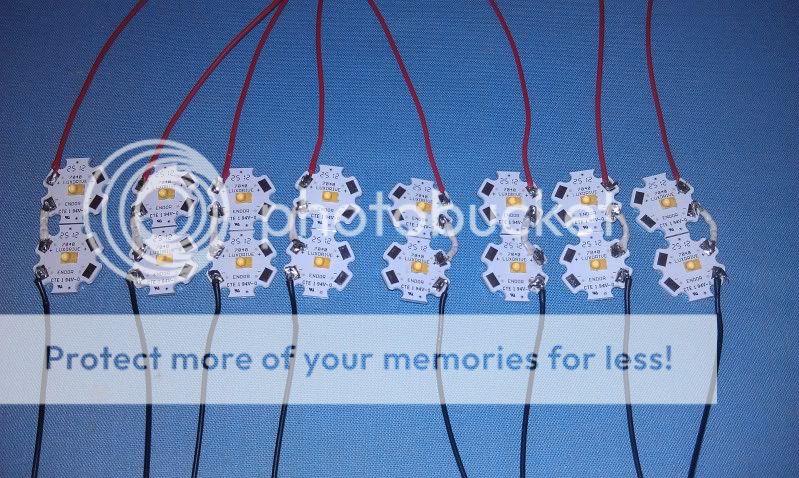
No one ever accused me of pretty solder joints
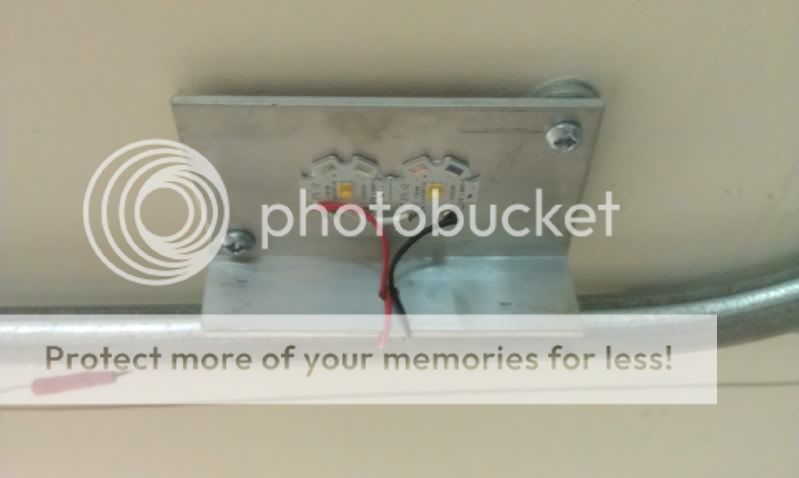
One of the four 2x fixtures in situ.
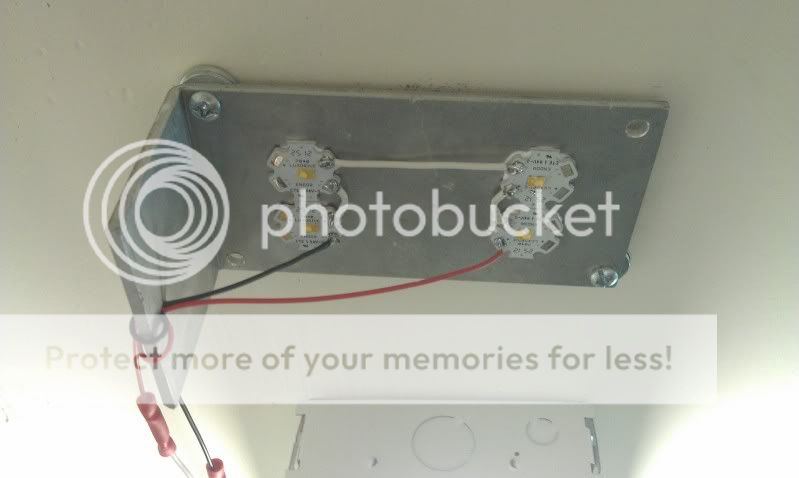
Adding to any confusion - one of the two 4x fixtures. The flange has a negligible effect on light distribution.
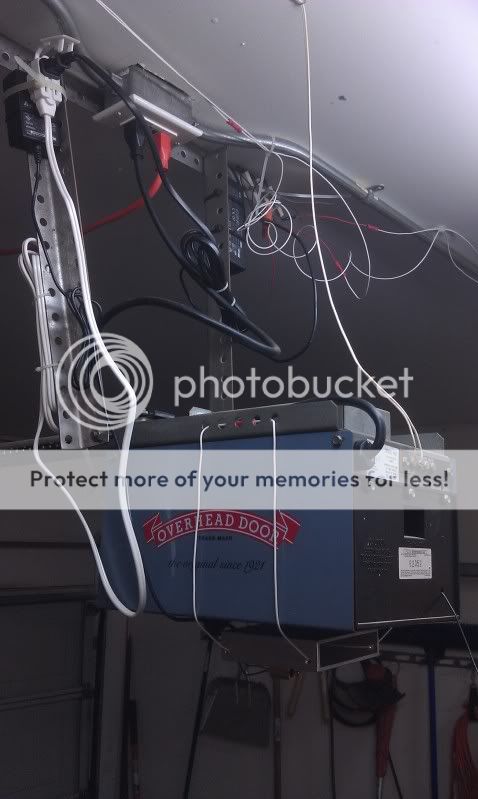
Nerve center of the operation. It has been cleaned up since I took that photo.
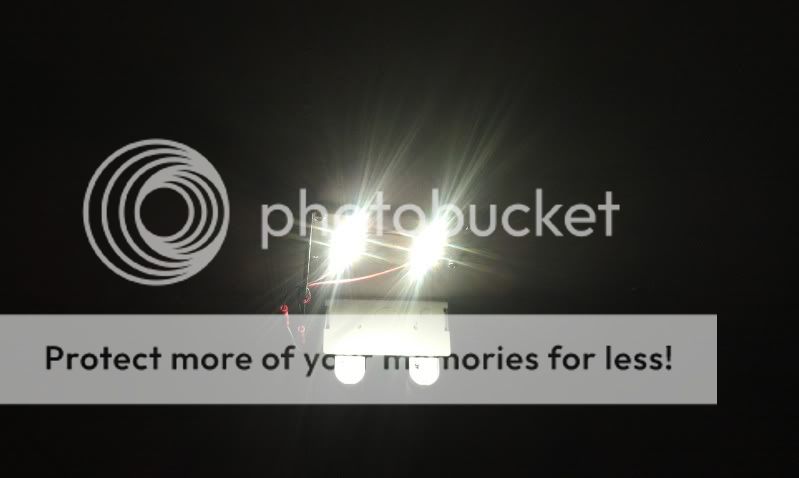
4x fixture at work making the exposure algorithm work trying to produce something slightly more intelligible than a giant flash of white.
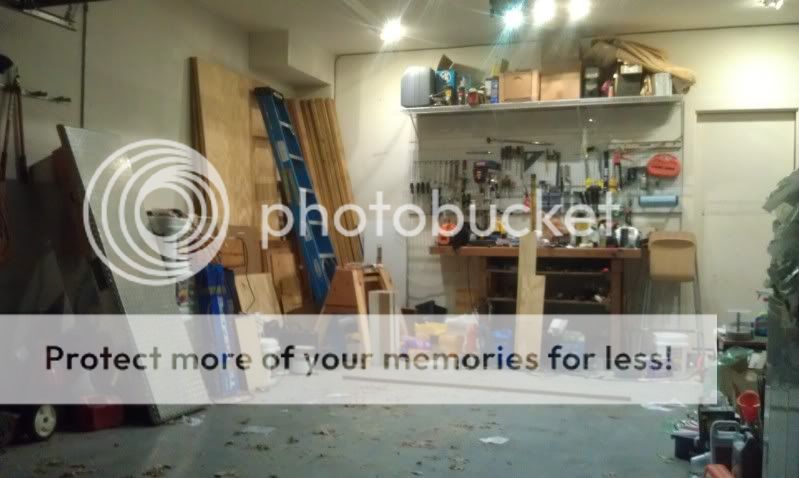
Outside looking in - this is both brighter and better-distributed than the original CFL nor terribly far off from what the floro fixtures achieve in terms of perceived brightness.
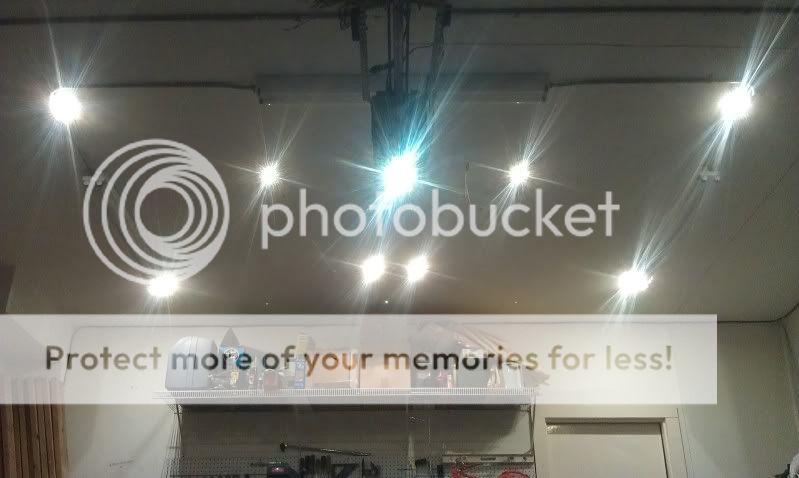
Staring into the finished product. Note the oddball standalone MC-E hanging below the garage door opener.
Bill of materials
In retrospect, while I'm pleased with the results, I'm glad I did a minor / secondary project with these discount rebels. Tint is all over the place, seemingly averaging something warmer than the advertised 4000K. Works fine for a utility space like the garage serving a truly utility function.
The garage door opener in my garage has a single Edison socket that's long been the home to the biggest CFL I could find - some 42W monster that took a long time to warm up and was truly too large to fit into most any fixture intended for an A19 lamp. It spat out a number of lumens some ~60 seconds after it fully warmed up, but the distribution was bad and like most cheap CFL's the spectrum was awful.
I happened across LED Supply's closeout on 4000K Rebel stars and bought 20 on impulse, thinking that a utilitarian task like lighting the garage for the ~5 minutes that the timer runs would be a good test of their capabilities and if they weren't so great, at least it's not a centerpiece of the house that would need hasty correction.
I also happened to locate a source of free power supplies (cabinets full of random unwanted power supplies for laptops and office phone systems), and snagged a 48V DC/250mA ISDN phone PSU alongside a 19V / 3.9A laptop brick. I was originally intending to use the 48V DC supply, but decided that the output might be a bit anemic and the intermittent operation called for good deal more power without so much regard for heatsinking.
The LED's are nominally rated with a Vf of 3V and are wired in 3 strings of 6. I assumed 1V of overhead to work with for current regulation, achieved via simple 2-ohm 10W power resistors (cheaper 5W resistors also would have sufficed). In a perfect world the LED's are seeing 500mA; in reality they're likely seeing less with additional contact resistances introduced by all the butt splices in the wiring and real-world Vf probably being > 3V. I did not measure current or voltages since the runtime on these is ~5 minutes at a time with hours between periods of operation.
I also happened to have an MC-E mounted to a large heatsink that was a sample I experimented with years ago - I powered that independently using a dedicated 16V supply. I may remove it since its cold color temperature clashes with the neutral-warmish rebels and it's not really needed anyway.
Anyway ... here are some pics.

No one ever accused me of pretty solder joints

One of the four 2x fixtures in situ.

Adding to any confusion - one of the two 4x fixtures. The flange has a negligible effect on light distribution.

Nerve center of the operation. It has been cleaned up since I took that photo.

4x fixture at work making the exposure algorithm work trying to produce something slightly more intelligible than a giant flash of white.

Outside looking in - this is both brighter and better-distributed than the original CFL nor terribly far off from what the floro fixtures achieve in terms of perceived brightness.

Staring into the finished product. Note the oddball standalone MC-E hanging below the garage door opener.
Bill of materials
- 18x "4000K" Rebel stars
- 19V x 3.95A HP laptop power supply
- Edison-to-socket adaptor
- Low-profile 2-prong extension cord
- Assorted aluminum angle and bar used as heatsinks (2x quad, 4x double, 2x single fixtures)
- ~75' 24AWG white wire
- Sheetrock anchors
- Cable clamps
- 22-14AWG butt splices
- ~75 1/4" washers (to stand off fixtures)
- Assorted tie wraps
- Liberal quantities of Pb/Sn solder
- Arctic Alumina adhesive
In retrospect, while I'm pleased with the results, I'm glad I did a minor / secondary project with these discount rebels. Tint is all over the place, seemingly averaging something warmer than the advertised 4000K. Works fine for a utility space like the garage serving a truly utility function.

